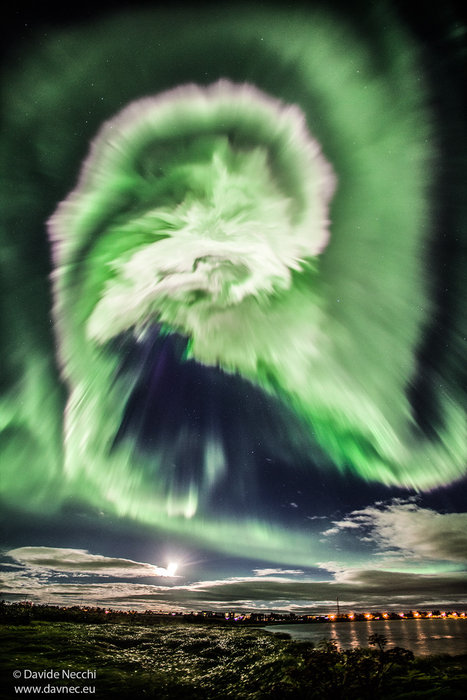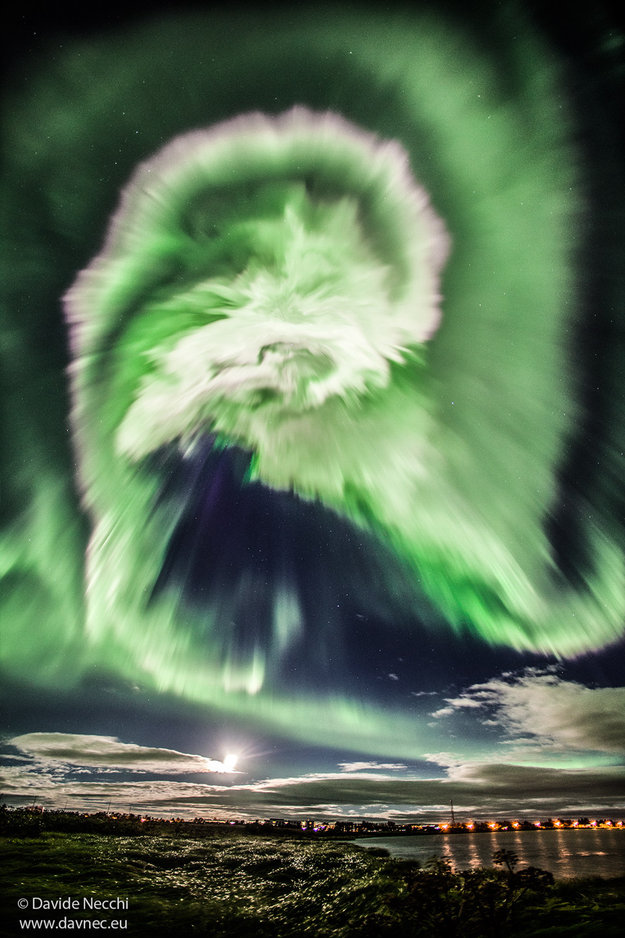
- Title A sinister-looking aurora over Iceland
- Released 31/10/2016 9:29 am
- Copyright D. Necchi (www.davnec.eu)
- DescriptionThis whirling, twisting skyscape is an arresting and somewhat intimidating sight – a perfect Halloween Space Science Image of the Week. Jagged lanes in shades of dark and pale green tangle with bright patches of white, creating a knotted spiral somewhat reminiscent of a celestial serpent writhing across the sky, looming ominously over the sleepy town below.It may look appropriately spooky and otherworldly, but this image shows something that is quite commonplace at Earth’s northern- and southernmost latitudes. The flashes of green in the sky are an aurora, seen when large bursts of energetic atomic particles stream out from the Sun and hit a planet’s atmosphere. These particles filter down through the protective layers surrounding Earth – such as the magnetosphere, the region of space dominated by the magnetic field – and interact with the air particles found below in the atmosphere. Patches of atmosphere subsequently glow brightly and eerily, filling our skies with startling ripples and flashes of colour.Auroras are often referred to as ‘the northern lights’ (aurora borealis), but they also occur regularly at southern latitudes (aurora australis). They are best seen from regions including Australia, New Zealand, Antarctica and parts of South America (southern), and Canada, Alaska, Scandinavia and Iceland (northern).The effect is seen only at polar and near-polar latitudes because the charged particles travel in towards Earth along magnetic field lines that meet our planet at its poles.Auroras are the most visible manifestation of the Sun’s effect on Earth. Since 2000, ESA’s quartet of Cluster satellites has been investigating the complex Sun–Earth connection and has been unravelling the puzzle of how and why auroras form.This image shows a town in southern Iceland named Selfoss, on the Ölfusá River (visible in the foreground). It was taken by photographer Davide Necchi on 27 August 2015. This particular aurora was linked to a solar storm, which caused an especially large and sudden outpouring of particles into our atmosphere. As a result, the lights were intense and unusually bright, appearing abruptly in the evening sky before it was fully dark. In fact, the aurora was so bright that Davide opted for a relatively short 3 second exposure time, conscious that any longer may cause the brightest parts of the photograph to ‘burn’ or become ‘blown-out’, thus losing detail.Necchi used a Canon 5D Mark II camera with a 14 mm f2.8 lens. This image had an ISO of 1600, and no filter has been applied. The bright full Moon is also visible in the frame, hanging beneath a layer of cloud.
- Id 367893
- Click on the tags to find the matching images.
- Activity Space Science
- Mission Cluster
- Set Space Science image of the week
Una inquietante aurora se cierne sobre Islandia
31 octubre 2016
El espectacular remolino que muestra el cielo de nuestra imagen científica de la semana resulta fascinante y hasta algo siniestro: ¡perfecto para Halloween! Franjas irregulares en distintos tonos de verde se entrelazan con fragmentos de un blanco brillante, creando una abigarrada espiral que podría recordar a una serpiente elevándose por el cielo, mientras se cierne, inquietante, sobre la ciudad dormida.
Pese a su aspecto sobrenatural y casi escalofriante, la imagen muestra algo bastante común en el norte de la Tierra, así como en las latitudes más australes. Los destellos verdes en el cielo no son más que una aurora, que puede verse cuando grandes emisiones de partículas atómicas cargadas escapan del Sol y chocan con la atmósfera de nuestro planeta. Estas partículas van filtrándose mientras atraviesan las distintas capas protectoras que rodean la Tierra, como la magnetosfera —región del espacio dominada por el campo magnético—, e interactúan con las partículas de aire que se encuentran por debajo, en la atmósfera. Así, ciertas partes de la atmósfera brillan de forma inquietante, cubriendo nuestros cielos con unos fantasmagóricos halos y luminiscencias de color.
Las auroras también se conocen como ‘luces septentrionales’ (aurora boreal), pero lo cierto es que se producen igualmente en el hemisferio sur (aurora austral). Los mejores lugares para verlas incluyen Australia, Nueva Zelanda, la Antártida y Sudamérica, en el sur. En el hemisferio norte, podemos disfrutar de ellas en Canadá, Alaska, Escandinavia e Islandia.
Su efecto solo puede apreciarse en latitudes polares o cercanas a estas regiones, ya que las partículas cargadas viajan hacia la Tierra a lo largo de las líneas del campo magnético que se encuentran en los polos.
Las auroras son la manifestación más claramente visible del efecto del Sol en nuestro planeta. Desde 2000, el cuarteto de satélites Cluster de la ESA investiga la compleja conexión Sol-Tierra, desentrañando el misterio de cómo y por qué se forman las auroras.
Esta imagen muestra una ciudad del sur de Islandia llamada Selfoss, a orillas del río Ölfusá (visible en primer plano). Fue capturada por el fotógrafo Davide Necchi el 27 de agosto de 2015. Esta aurora en concreto se debía a una tormenta solar, que proyectó hacia nuestra atmósfera un torrente de partículas enorme y repentino. Así, sus destellos resultaron extraordinariamente intensos y brillantes, apareciendo en el cielo al atardecer, antes de que estuviera completamente oscuro. De hecho, esta aurora fue tan brillante que Davide optó por un tiempo de exposición relativamente corto, de 3 segundos, consciente de que si lo prolongaba demasiado, las partes más brillantes de la fotografía podrían quemarse o aparecer completamente blancas, por lo que se perderían los detalles.
Necchi empleó una cámara Canon 5D Mark II con un objetivo 14 mm f2.8. La imagen presenta un valor ISO de 1.600 y no se le ha aplicado ningún filtro. En la imagen también aparece una brillante luna llena por detrás de una capa de nubes.
ESA
Guillermo Gonzalo Sánchez Achutegui


No hay comentarios:
Publicar un comentario